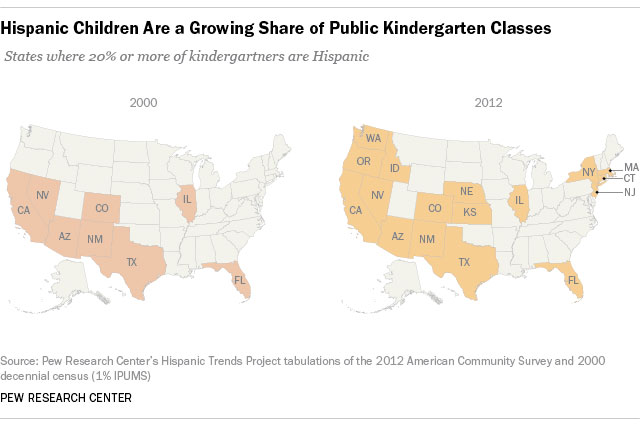A view of the future through kindergarten demographics [INSIGHT]
July 12, 2014
![]() Today’s kindergartners offer a glimpse of tomorrow’s demographics. A new data analysis by Pew Research Center finds a big increase over the past decade in the number of states where at least one-in-five public school kindergartners are Latino.
Today’s kindergartners offer a glimpse of tomorrow’s demographics. A new data analysis by Pew Research Center finds a big increase over the past decade in the number of states where at least one-in-five public school kindergartners are Latino.
There are 17 states where Latino children comprise at least 20% of the public school kindergarten population, according to our analysis of 2012 Census Bureau data. By comparison, just eight states had such a composition a decade earlier, in 2000.
Hispanic Kindergartners in America
At 54 million, Hispanics are the largest minority group. They make up 17% of the nation’s population, and have dispersed across the nation. The states where at least one-in-five kindergartners are Hispanic include some states with historically few Hispanic immigrants, such as Nebraska, Idaho and Washington. In Kansas and Oregon, fully one-in-four kindergartners are Hispanic, the same share as in New York, which has the fourth-largest Hispanic population in the country.
Fueled in part by Hispanic population growth, there may be more minorities in classrooms when school starts this fall (among them blacks, Asians and Hispanics) than white students nationwide in K-12 public schools, according to U.S. Department of Education projections. In 2014, some 50.3% of students are projected to be minorities. That’s a sharp increase from 1997, when minorities made up just 36.7% of students.
Minorities also are expected to become the majority in the United States in the coming decades. Minorities today make up about 37% of the overall population, with the share projected to increase to 57% by 2060, according to the Census Bureau. Among people of all ages, there are four states where minorities make up a majority of the population—California, Hawaii, New Mexico and Texas.
Looking ahead, nearly half of babies born in the U.S. today are a racial or ethnic minority, though they are not yet a majority. The number of Hispanics has increased in recent years primarily due to births, as the number of Hispanic immigrants has stalled after four decades of rapid growth. In 2012, one-in-four of the nation’s newborns were Hispanic. By 2060, Hispanics are projected to make up 31% of the overall U.S. population.
By Jens Manuel Krogstad
































